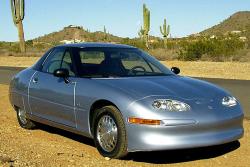Human machinery uses a lot of energy. Nikola Tesla’s Polyphase Alternating Current system was installed at Niagara Falls in 1896. Even after 115 years, our electric infrastructure still uses the same basic concepts.
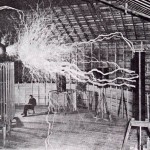
While nuclear power plants started to generate electricity in the 1960’s, most of our electricity is still made from falling water (hydropower) and burning coal.
Did things have to be this way? Nikola Tesla promised that our machinery would one day be powered by “the very wheelwork of nature”, whatever that means.
But for all his technical genius, Tesla’s ambitions were constantly stymied for lack of money, and perhaps an inability to be practical. Financier J.P. Morgan’s vision of an electric meter on every home won out.
Oh well.
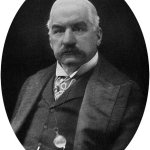
The economy uses a lot of energy, and perhaps this is by design. There have been many technologies that use substantially less energy than their competitors. But these never took off for lack of vision, or for a lack of funds to complete research & development.
Electric Vehicles
While walking through a parking lot in Phoenix Arizona in the spring of 1999, I saw an oddly-shaped little car. After a moment or two, I recognized it for what it was: a GM EV-1, the first mass-produced and purpose-designed electric vehicle in the modern era.
Automobiles powered with gasoline basically require a hydrocarbon industry to buy fuel from. It is possible for someone to create their own biodiesel, but farming for fuel is a rather inefficient use of resources.
Electric cars are more efficient than gasoline-powered cars for several reasons.
From my perspective, their main advantage is that they can be charged with electricity that comes from any source: hydro, solar, coal, natural gas, uranium, wind, etc. A person could build their own wind generator to charge their car. Someone who lives next to running water might set up a small microhydro generating system.
One standard complaint about electric vehicles is that the batteries aren’t good enough. But how many vehicles are only used for 10-30 miles a day? Security vehicles can only take so many laps around the mall.
The very first EV1s were only sold in Southern California and Arizona because the lead-acid batteries only worked in the warm temperatures available in these two areas. The 2nd generation EV1’s Nickle-Metal Hydride batteries didn’t charge very well in hot weather, and these were mostly sold in California.
As will be covered, lead-acid battery technology that is still useful in cold-weather was being experimented with, so this is no longer a concern.
The EV1 was really a prototype that was allowed into circulation. When the program was finished, GM took their leased prototype cars back. Most were sent to the crusher, a few survive in museums.
From one perspective this is understandable, considering laws which would have required GM to supply EV1 parts for a decade or longer.
One reason Toyota allowed the RAV-4 EV to be sold once their leases expired was because the RAV-4 EV was based on a car already in production. There was no need to create a special line of parts that someone might need, someday. Over half of the RAV-4 EVs produced a decade ago are still on the roads today.
The Hybrid Folly
Gasoline-electric hybrid cars are all the rage today. While they go a couple miles farther on a gallon of gas than a plain internal combustion engine, little of this improvement is due to the actual batteries. The 1992 Honda Civic VX was stickered for 55mpg on the highway. My 1994 Civic VX, with 212,000 miles, still gets over 50 mpg on the highway, even with the hit (10%?) from the ethanol that wasn’t polluting the fuel supply 19 years ago.
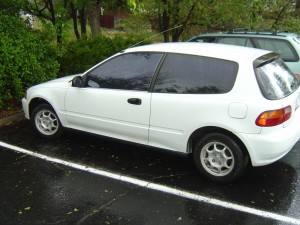
The 2002 Honda Civic hybird was only a small evolution from the 1992 VX. Honda’s Hybrids use a lean-burning engine, just like my 17-year-old 50+mpg Civic. The most substantial differences between my car and the 2002 hybrid is a $1000 battery, a continuously-variable transmission, and a catalytic converter to break down the nitric oxide pollutants (which are created when the engine is in the lean-burn mode).
How long did the Chevy Volt take to develop? GM poured a ton of money into the Volt’s research and development, but the resulting car is rather complex. And $6000 or $8000 is a lot for a manufacturer to spend on a battery pack.
AC Propulsion (the company behind the EV1’s drivetrain) developed a trailer to provide extended range with a motorcycle engine and generator. For anyone who’s ever struggled to back up a car with a trailer, the movie (archive.org) is rather incredible: “The intelligent BackTracker trailer steering maintains trailer-to-vehicle alignment during backing to avoid jack-knifing.”
While the EV-plus-trailer is not as efficient as the Volt or other pluggable hybrid, with a range-extending trailer you only lug the heavy engine around when you know you’ll need it. AC Propulsion’s electric drivetain solution includes an onboard charger that uses whatever kind of plug is available, so no special equipment is required for regular charge-ups at your friend’s house.
Cheap High-Capacity Batteries
The heavy-equipment manufacturer Caterpillar had a problem with an excessive number of warranty claims for batteries. To reduce their warranty costs, they put someone who didn’t know anything about batteries in charge of a project to find a solution.
For the last 100+ years, automotive batteries have consisted of plates of lead submerged in acid. Caterpillar’s engineers came up with a lead-acid battery that replaced the plates with light-weight carbon-graphite “foam”. The foam is covered with a thin layer of lead. This results in a battery that has dramatically more lead exposed to the battery acid.
Firefly Energy was spun off, and proceeded to develop and refine their innovative battery. The promise was a battery with the capacity of Nickle-Metal Hydride ($$$), for the cost of lead (cheap).
The company’s first product was to be a battery for truckers’ air conditioning systems. Truckers have traditionally left their rigs idling overnight, to keep their cabins comfortable. New regulations in California changed the rules about idling engines. The Firefly battery was to be used to power the heating, air conditioning, and hotel loads while the driver rested.
Then the economy hit. Stimulus funds went to “advanced chemistry” batteries (those based on Lithium, which is imported from China), and Firefly went bankrupt.
The technology might have a heartbeat. The intellectual property was purchased by a company based in India, and Firefly’s website says the transformation to Firefly International Energy Co was completed on October 1st, 2010.
Gas-electric hybrid vehicles stop the engine to keep from wasting gas at stoplights and in traffic jams. The energy stored in the hybrid’s large battery is used to repeatedly restart the engine, and power the climate control while the engine is off.
If automobile engineers had a relatively-cheap high-capacity battery available, they could design idle-stop into every car on the road. But there just isn’t enough capacity in cheap lead batteries to continuously start and stop an engine in traffic.
Both mild-hybrid and idle-stop systems would be a lot more feasible if a better battery like Firefly’s was available.
Geothermal Heat Pumps
When a gas is compressed it heats up; when it decompresses it cools down. A heat pump is a device that moves heat into and out of a building with the compression and decompression of gas.
Every air conditioning unit is a heat pump. In climates where it doesn’t get too cold, heat pumps (reversible ACs) are used to provide heat in the winter.
AC condensers work by dissipating heat from the just-compressed coolant. My aunt lives in Phoenix, Arizona. Her air conditioning condenser is on the south side of her house. On the hottest days of the year, her AC system uses electricity to move heat in the 77-degree house into the sun-drenched 120+ degree condenser coils.
The condenser at my grandfather’s house a few miles away is entirely shaded by a grapefruit tree and the house, but moving heat into 115-degree outside air is still a sub-optimal solution.
While the temperature of the air in a particular location varies widely based on time of day and season, the temperature of the ground (below 10 feet or so) is relatively constant throughout the year.
In a geothermal system, the condenser coils are placed underground. Instead of moving the heat in a 77-degree house to 120-degree outside air, the heat energy is dispersed in the 70-degree ground. A properly-designed geothermal system uses significantly less electricity to move the same amount of heat into and out of a building.
The reason geothermal heat pumps are not commonly used is that constructing a “ground loop” costs a lot more for installation.
Most geothermal systems are installed at large buildings and complexes, like schools. The most expensive part of a geothermal system is drilling the wells. In larger installations, one well site is used for many buildings. According to Wikipedia, “The payback period for larger commercial systems in the USA is 1–5 years, even when compared to natural gas.”
Apartment complexes are ideally suited to geothermal systems. My brother recently moved into a new apartment complex in Houston, Texas. One morning I went up towards the roof, and noticed hundreds of AC condensers baking in the sun.
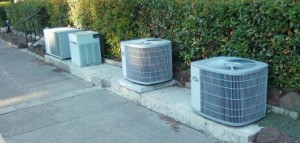
If developers of apartment complexes installed geothermal systems, their residents would use dramatically less electricity for heating, cooling and heating water.
But apartment owners don’t care how much their tenants pay for electricity. So they put the cheapest system possible in, and over the decades their tenants use millions more kilowatt-hours of electricity than if the developer had installed the superior system.
Oh well.
Disruptive Technology
Development of Angel Labs’ Mighty Engine has been in fits-and-starts over the last 6+ years because of a lack of money. There have been plenty of offers to buy the inventor’s patents outright, but Raphial has the gumption to think that he should be the one to profit from his revolutionary design.
I think the greatest potential for this engine is not as a powerplant for a car, but as a more efficient pump. Massive amounts of electricity is used to power the pumps in air conditioners and the pumps that move canal water uphill.
Use As Much Energy As Possible
Under our current system of money and finance, Wall Street is trusted to plan for the economy’s future energy needs. Wall Street invests where it sees the most potential for payoff, and THEY make more money when the economy uses as much energy as possible.
Like a rigged carnival game, the energy economy is specifically distorted so that we have little choice but to send lots of money to our financiers’ energy companies.
But hope spring eternal. Nikola Tesla grokked (understood at a fundamental level) the relationship between light, electromagnetism and gravity, which is more than even today’s scientists can offer. I trust that he knew what he was talking about when he offered this statement:
Ere many generations pass, our machinery will be driven by a power obtainable at any point of the universe. This idea is not novel. Men have been led to it long ago by instinct or reason; it has been expressed in many ways, and in many places, in the history of old and new. We find it in the delightful myth of Antheus, who derives power from the earth; we find it among the subtle speculations of one of your splendid mathematicians and in many hints and statements of thinkers of the present time. Throughout space there is energy. Is this energy static or kinetic! If static, our hopes are in vain; if kinetic – and this we know it is, for certain – then it is a mere question of time when men will succeed in attaching their machinery to the very wheelwork of Nature.
-“Experiments with alternate currents of high potential and high frequency” (February 1892)
